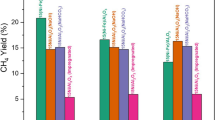Abstract
The thermal decomposition of ammonium perchlorate (AP) is considered to be the first step in the combustion of AP-based composite propellants. In this report, the effect of the specific surface area of titanium oxide (TiO2) catalysts on the thermal decomposition characteristics of AP was examined with a series of thermal analysis experiments. It was clear that the thermal decomposition temperature of AP decreased when the specific surface area of TiO2 increased. It was also possible that TiO2 influences the frequency factor of AP decomposition because there was no observable effect on the activation energy.




Similar content being viewed by others
References
Fujimura K, Miyake A. Sci Technol Energ Mater. 2008;69:149.
Krishnan S, Jeenu R. Combustion characteristics of AP/HTPB propellants with burning rate modifiers. J Propuls Power. 1992;8:748–55.
Chakravarthy SR, Price EW, Sigmant RK. Mechanism of burning rate enhancement of composite solid propellants by ferric oxide. J Propuls Power. 1997;13:471–80.
Fong CW, Hamshere BL. The mechanism of burning rate catalysis in. Composite HTPB-AP propellant combustion. Combust Flame. 1986;65:61–9.
Fong CW, Hamshere BL. The mechanism of burning rate catalysis in composite propellants by transition-metal complexes. Combust Flame. 1986;65:71–8.
Dubey BL, Nath N, Tripathi A, Tiwari N. Catalysed. combustion of ammonium perchlorate, polystyrene and their composite propellants. Indian J Eng Mater Sci. 1994;1:341–9.
Pearson GS. Composite propellant catalysts: copper chromate and chromite. Combust Flame. 1970;14:73–84.
Patil PR, Krishnamurthy VN, Joshi SS. Differential scanning calorimetric study of HTPB based composite propellants in presence of nano ferric oxide. Propellants Explos Pyrotech. 2006;6:442–6.
Li W, Cheng H. Cu-Cr-O nanocomposites: synthesis and characterization as catalysts for solid state propellants. Solid State Sci. 2007;9:750–5.
Small JL, Stephens MA, Deshpande S, Peterson EL, Seal S. Proceedings of 20th international colloquium on the dynamics of explosions and reactive systems, Montreal, July 31–August 5, 2005.
Pivkina A, Frolov Yu, Ivanov D. Nanosized components of energetic systems: structure, thermal behavior, and combustion. Combust Expl Shock Waves. 2007;43:51–5.
van der Heijden AEDM, Leeuwenburgh AB. HNF/HTPB propellants: influence of HNF particle size on ballistic properties. Combust Flame. 2009;156:1359–64.
Shen SH, Chen SI, Wu BH. The thermal decomposition of ammonium perchlorate (AP) containing a burning-rate modifier. Thermochim Acta. 1993;223:135–43.
Rocco JAFF, Lima JES, Frutuoso AG, Iha K, Ionashiro M, Matos JR, et al. Thermal degradation of a composite solid propellant examined by DSC. J Therm Anal Calorim. 2004;75:551–7.
Longuet B, Gillard P. Experimental investigation on the heterogeneous kinetic process of the low thermal decomposition of ammonium perchlorate particles. Propellants Explos Pyrotech. 2009;34:59–71.
Boldyrev VV. Thermal decomposition of ammonium perchlorate. Thermochim Acta. 2006;443:1–36.
Halawy SA, Al-Shihry SS. Role of the acidic-basic characters of some metal oxides in the pyrolysis of ammonium perchlorate. J Therm Anal Calorim. 1999;55:833–40.
Chen L-J, Li G-S, Qi P, Li L-P. Thermal decomposition of ammonium perchlorate activated via addition of NiO nanocrystals. J Therm Anal Calorim. 2008;92:765–9.
Ozawa T. Kinetic analysis of derivative curves in thermal analysis. J Therm Anal Calorim. 1970;2:301–24.
Acknowledgements
This research was supported by the Technical Research & Development Institute at the Ministry of Defense. We would also like to acknowledge Professor Kohga of the National Defense Academy for his assistance and advice on performing specific surface area measurements.
Author information
Authors and Affiliations
Corresponding author
Rights and permissions
About this article
Cite this article
Fujimura, K., Miyake, A. The effect of specific surface area of TiO2 on the thermal decomposition of ammonium perchlorate. J Therm Anal Calorim 99, 27–31 (2010). https://doi.org/10.1007/s10973-009-0462-0
Published:
Issue Date:
DOI: https://doi.org/10.1007/s10973-009-0462-0




